Polish-language Telegram channels spread anti-refugee narratives
The DFRLab identified 27 Telegram channels spreading anti-refugee disinformation as Ukrainians flee to Poland.
Polish-language Telegram channels spread anti-refugee narratives
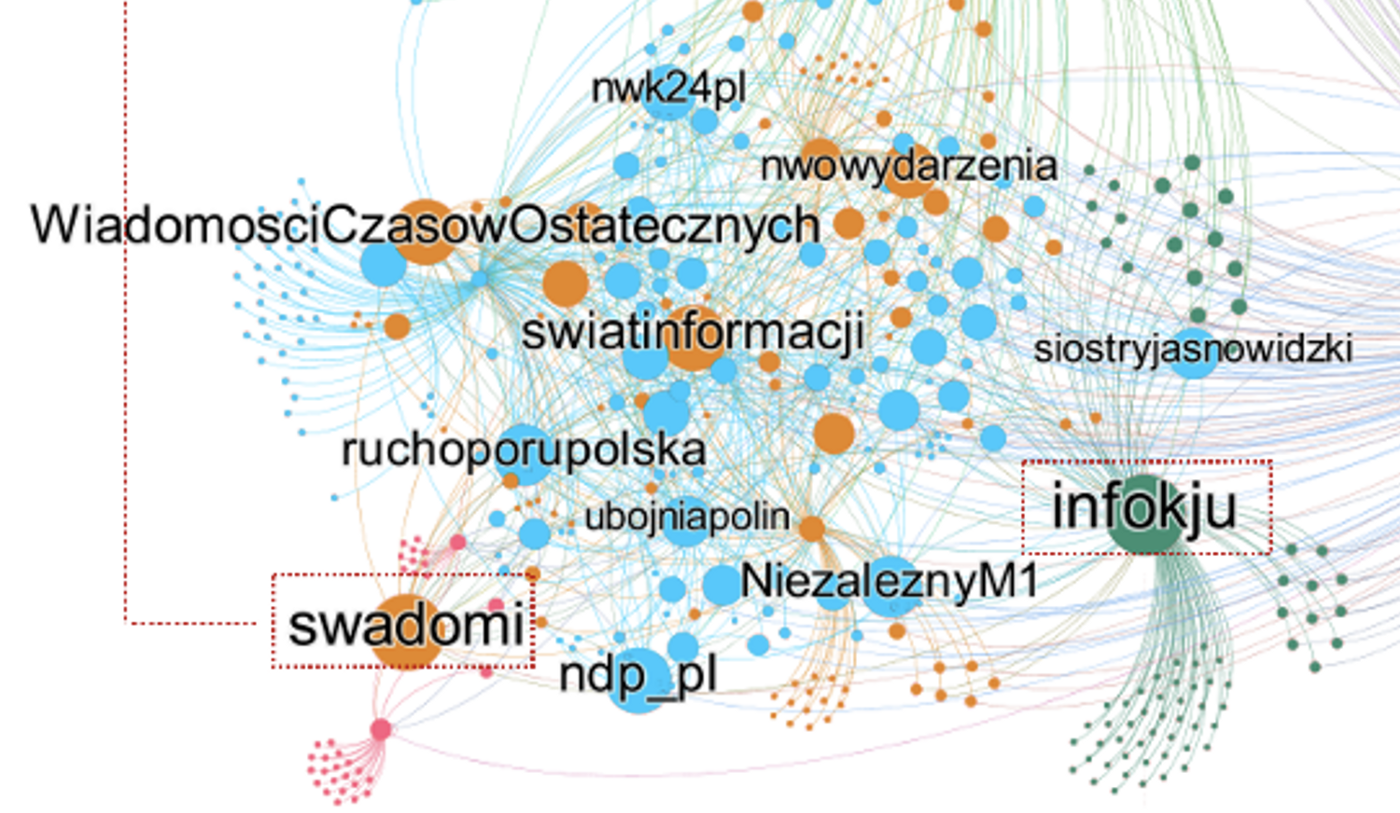
BANNER: A network graph showing the connections between the analyzed channels. (Source: @estebanpdl/DFRLab via Telegram API)
Polish-language Telegram channels are spreading unsubstantiated claims about Ukrainian refugees in an apparent attempt to shift public opinion about the influx of Ukrainians arriving in Poland. The DFRLab analyzed 27 Telegram channels that spread anti-refugee, pro-Kremlin, and at times, anti-vaccine content. Some of the channels appear connected, as they have published identical posts or forwarded posts from each other. A few of the channels originally published content in Russian, but later switched to publishing in Polish.
The Telegram channels depict Ukrainian refugees as aggressive and a threat to host countries. In contrast, the Russian armed forces are often portrayed as welcome liberators. The analyzed channels made unsubstantiated claims about Ukrainian refugees being more privileged than Polish citizens because they receive free state services. The Telegram channels also attempt to discourage Polish families from hosting refugees by painting them as violent. These anti-refugee narratives bolster negative sentiments about the support programs, both government and citizen-led, that have emerged for Ukrainian refugees in Poland. The Telegram channels have a history of promoting conspiratorial content; prior to Russia’s invasion of Ukraine, the majority of the channels actively posted conspiracy theories about COVID-19 and anti-vaccine content.
According to the United Nations, more than 3.3 million refugees crossed the border from Ukraine into Poland between February 24 and May 13, 2022, but the exact number of refugees staying in Poland is unknown. As of April 25, more than one million Ukrainian refugees had received a Polish national identification number (PESEL), with more refugees expected to obtain the national ID. A poll conducted by IBRiS in March found that more than 90 percent of Poles supported accepting refugees, however, Polish migration experts have warned that positive attitudes towards refugees may fade over time.
Telegram channel overview
The DFRLab used Telegram analytics tool TGStat to analyze 27 Telegram channels that amplify anti-refugee content. In total, the 27 channels had garnered more than 120,000 followers as of May 10, 2022. Utilizing Telegram’s API, we collected further data on the channels and discovered that seven were created after Russia’s February 24 invasion of Ukraine. The most popular channel was Wiadomości Czasów Ostatecznych (“News of the End Times”), with 14,300 subscribers. The second most popular channel was Polska Grupa Informacyjna (“Polish Information Group”), with nearly 12,300 subscribers. The third most popular channel, Ktoś (“Someone”), had 10,500 subscribers. When analyzing the creation dates of the Telegram channels, the DFRLab found that some of the channels were created on the same day, while others were created one day apart.
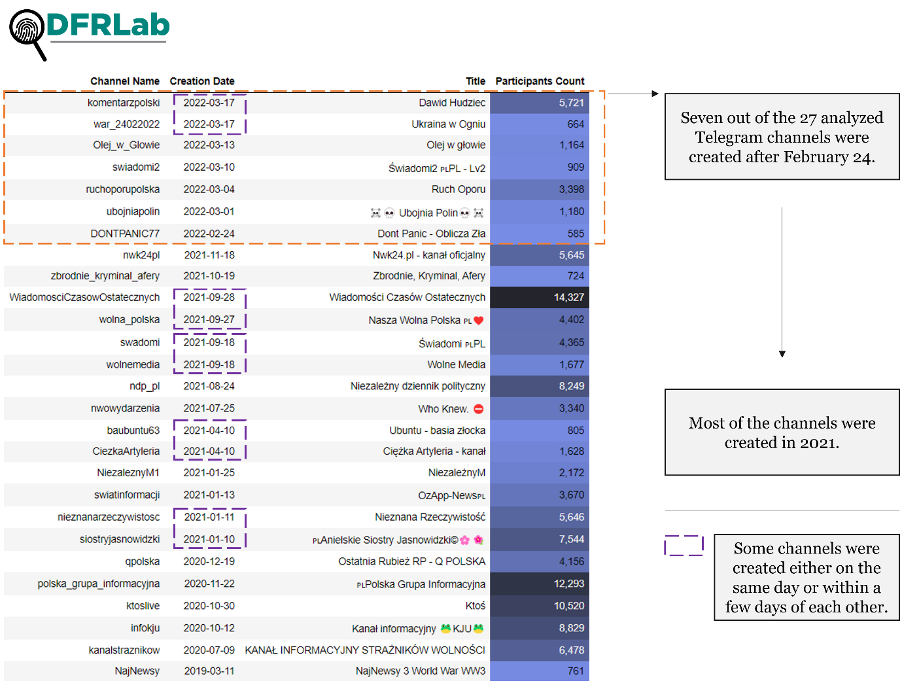
The DFRLab collected more than 230,000 Telegram messages from these channels posted between March 2019 and May 2022. During this time period, the channel with the highest number of posts was Ostatnia Rubież RP — Q POLSKA (“The last Frontier of the Republic of Poland — Q POLSKA”), with more than 73,500 messages. Next, Kanał informacyjny (“Information channel”) posted more than 30,000 messages. The total number of posts from all of the channels sharply increased in 2021, as this is the year most of the analyzed channels were created. However, the highest increase in published posts was on February 24, 2022, the day Russia invaded Ukraine.

Anti-refugee narratives shared by Telegram channels
In the 27 channels analyzed by the DFRLab, we found multiple anti-refugee narratives circulating in Polish. One widely amplified narrative claimed that Ukrainian refugees are more privileged in Poland than Poles. One Telegram post said that Poles must work hard to earn money, while Ukrainians, who were frequently referred to as “displaced persons” instead of refugees, do not have to work because they get “everything for free” in Poland. Another post accused the “so-called refugees” from Ukraine of behaving as though they are superior to Polish citizens. In a different Telegram post, it was claimed that the influx of refugees from Ukraine had caused Poland’s unemployment rate to rise by 70 percent between January 2022 and March 2022. However, data from Poland’s Central Statistical Office shows the unemployment rate actually decreased by 0.1 percent during the same period.
The Telegram channels also asserted that Ukrainian refugees were dissatisfied with the conditions inside shelters, and had unrealistic expectations when they were fleeing to the European Union. These posts imply that the conditions inside the facilities offered by host countries are satisfactory, yet Ukrainian refugees do not appreciate the support. In view of this, some Telegram channels suggested that refugees should be sent “back to their basements” in Ukraine if they are unhappy with their living conditions in other parts of Europe.
The DFRLab identified at least four Telegram channels that posted the same video with identical captions. The video claimed that a Polish woman had found jobs for Ukrainian refugees, but they allegedly refused to work. The posts asserted that Ukrainian refugees were surprised they needed to work in Poland because they expected everything would be free for them, including accommodation. It appears that this post was first shared by the Ktoś Telegram channel on April 1. Three other channels shared identical posts on April 3 without citing the original post from Ktoś.

When describing the arrival of Ukrainian refugees in Poland, the Telegram channels used terms such as “Ukrainization of Poland” and “invasion.” They claimed that more than half of the Ukrainian refugees who had arrived in Poland as of April 6 were either wealthy individuals who did not require help from Poland, or men who did not want to die fighting for the “Kyiv regime.” Some posts criticized refugees for spending social assistance funds on clothing.
In addition, one Telegram post claimed that unlike Polish political leaders, Polish citizens remember who killed and tortured Poles between 1943 and 1944, a reference to the Volhynia massacre, in which Poles were killed by an insurgent Ukrainian army. The post draws parallels between the historic event and current attitudes of Ukrainians towards Poles. “Now so-called refugees behave the same way, trying to demonstrate their superiority over local people in the streets,” the post claimed.
The analyzed Telegram channels portray Ukrainian refugees as aggressive people who pose a threat to public safety in their host countries. Some of the channels published identical posts saying that Ukrainian refugees in Germany had allegedly robbed the apartment of their host. Another post blamed Ukrainian refugees for a fight that occurred on a bus in Poland. Other posts accused Ukrainian refugees of showing aggressive behavior towards locals in Italy.

In addition, some Telegram posts shared photos of various monuments in the European Union painted blue and yellow, the colors of the Ukrainian flag, to accuse Ukrainian refugees of defacing monuments. At least one post compares Ukrainian refugees defacing monuments with “bandits and Nazis.” Another channel blamed Ukrainian refugees for the worsening COVID pandemic in Poland, claiming they had left Ukraine without being vaccinated. Interestingly, the same channel posted anti-vaccine content before the war.
The Telegram channels also warned Poles about the alleged risks associated with hosting refugees in their own homes. One channel shared an unverified anecdote that claimed a Ukrainian refugee had kicked his hosts out of their own home. The post says that Poles should never accept Ukrainians with refugee status into their homes because it may be impossible to remove them in the future. Some Telegram channels also asserted that Poland should not accept refugees because other European countries do not want to accept refugees from Ukraine. One post stated, “Lithuania does not need Ukrainian refugees,” while another post claimed that people in Latvia would not rent apartments to Ukrainians, even if they had the funds to pay rent. Another Telegram channel claimed that both male and female refugees used OnlyFans, an app commonly used by sex workers, to sell drugs in Europe, with the alleged goal of sending some of their profits to the Ukrainian armed forces.
Anti-Ukraine and pro-Russia narratives pushed by Telegram channels
In addition to sharing anti-refugee content, the Telegram channels also amplified anti-Ukrainian sentiments. Many of the narratives used by the Kremlin to justify the war or avert blame for atrocities were also shared by the Telegram channels. Some of the channels repeatedly shared anti-Ukrainian statements made by Ukrainian pro-Kremlin lawmaker Ilya Kyva, who was recently charged with infringing on Ukraine’s territorial integrity. Other posts contained videos allegedly depicting Ukrainians staging victims of the Bucha massacre in order to accuse Russia of committing war crimes. Some of the Telegram channels accused the Ukrainian armed forces of torturing and killing prisoners of war, while other channels accused the Ukrainian army of killing civilians in Bucha, Kramatorsk and the Donbas. Channels also claimed that Ukraine had bombed the Kramatorsk rail station with Tochka-U missiles on April 8, killing more than 50 civilians. Some Telegram channel accused “terrorists” from the Azov battallion of shooting civilians in Mariupol and Donbas. One Telegram channel compared Ukraine with ISIS.
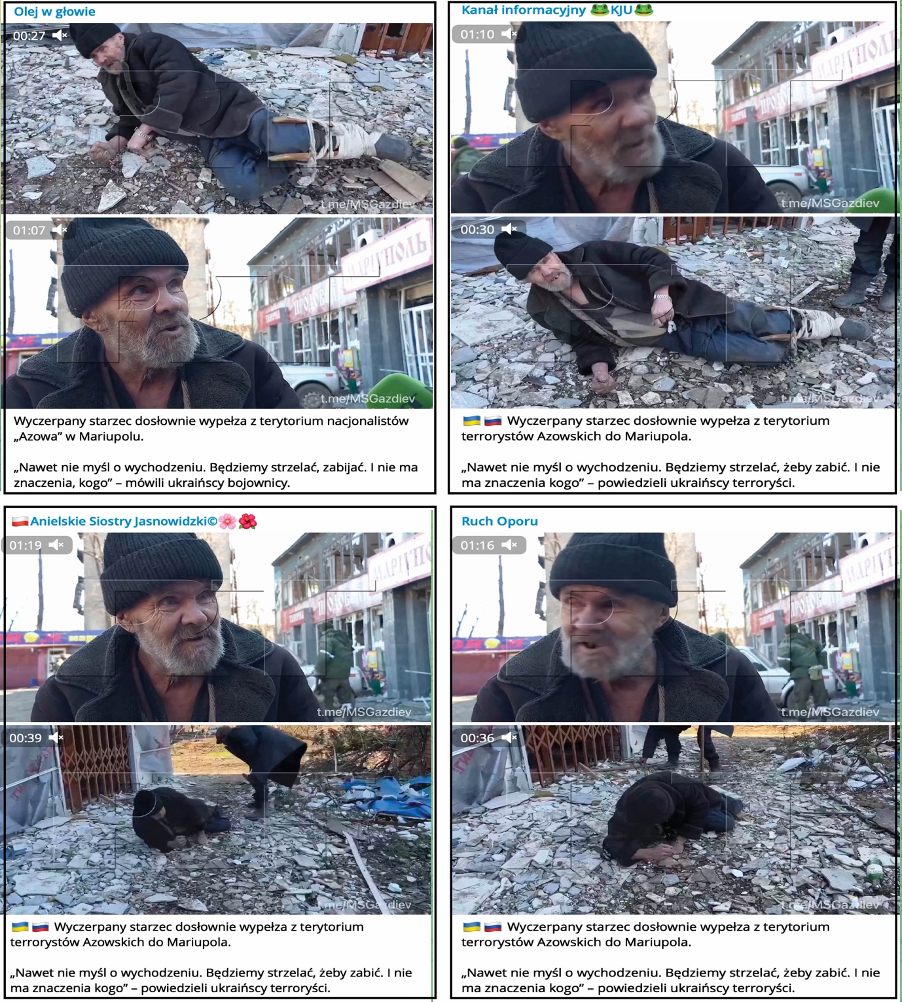
In contrast, the Telegram channels portray the Russian armed forces as liberators of Ukrainian people in the Donbas. Some posts claimed that residents of the Donbas welcomed Russian soldiers with flowers after they liberated Mariupol from Ukrainian nationalists. Multiple videos amplified by these channels showed Mariupol residents expressing gratitude towards Russian forces. Some posts claimed that Russia sent more than 1,000 tons of humanitarian aid to Donbas, while others stated that residents of Moscow adopted orphans from Donbas. Other Telegram channels also posted videos of what they claim are Mariupol residents accusing the Azov Battalion of committing genocide in Mariupol, raping girls in basements, and shooting children.
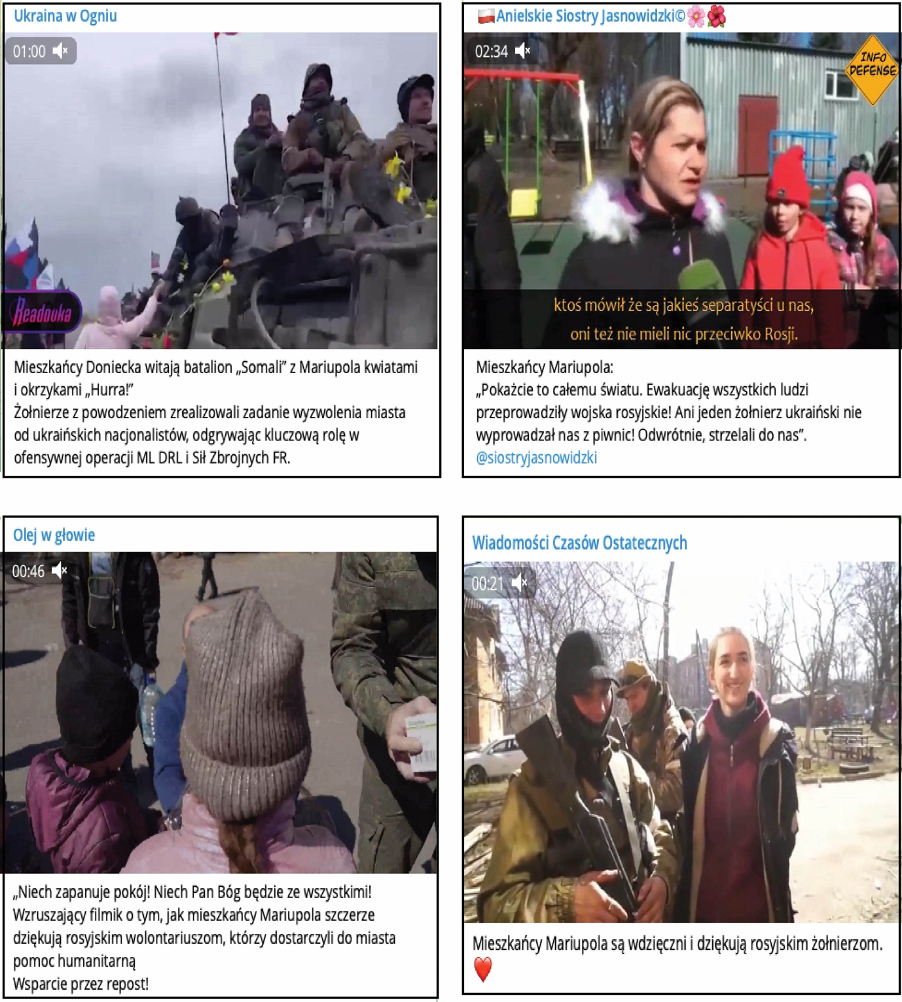
Apart from posting anti-refugee content, the majority of identified Telegram channels also posted anti-vaccine content. Some of these posts accused the European Medecines Agency (EMA) of killing people, while others implied vaccines are deadly.
The DFRlab monitored how often the 27 Telegram channels used eight specific keywords in their messages: “Uchodźcy” (“refugees”), “Naziści” (“Nazis”), “Ukraina” (“Ukraine”), “Banderowcy” (“Banderites,” derived from the name of the late Ukranian nationalist Stepan Bandera and denotes supporters Bandera’s Organization of Ukrainian Nationalists), “Bandery” (“Bandera,” a synonym of Banderite), “COVID”, “Szczepionka” (“vaccine”), and “Szczepień” (“vaccination”). The most frequently used keywords related to COVID, but this could be explained by the fact that COVID beganmore than two years before the war.
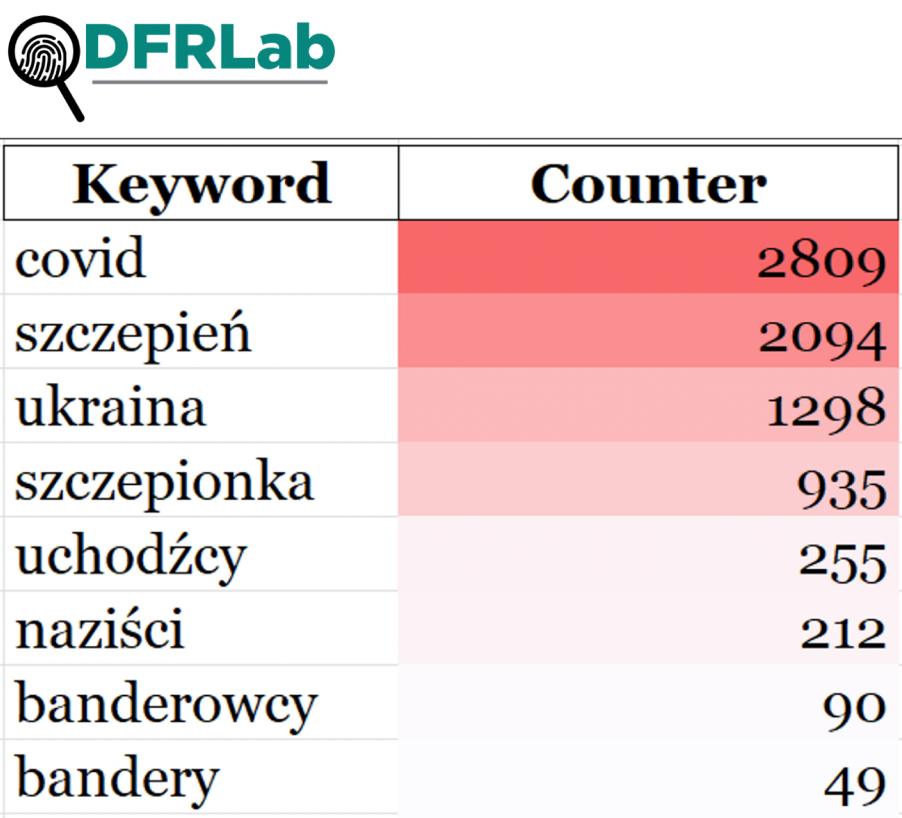
The DFRLab also explored the connections between the monitored keywords and the analyzed channels. The following graph shows the interactions between the channels and keywords.
Analysis of Telegram channel origins
The DFRLab found that when some of the Telegram channels were first created, they posted content in Russian but later switched to posting exclusively in Polish. These channels claim to be Polish in their biographies, but the early Russian language posts raise the possibility that the administrators might be a native Russian speaker. During the migrant and refugee crisis on the Polish-Belarus border in the fall of 2021, the third most popular Telegram channel analyzed, Ktoś (“Someone”), shared anti-Poland and pro-Belarus narratives. It is noteworthy that the word for “someone” in Belarusian is Нехта (“Nexta”), the name of a well-known Belarusian Telegram channel. Nexta’s popularity significantly increased during anti-government protests in Belarus in August 2020. The Ktoś channel was created in October 2020, and its first posts were about large scale anti-government protests in Poland over a proposed abortion ban. The DFRLab could not find a connection between the Polish and Belarusian Telegram channels.
One post in the channel Оlej w głowie (“Oil in the head”) contained a link to an article published in Russian on Telegra.ph, a free web publishing platform, with the title, “OnlyFans and drugs: what choice do Ukrainian refugees have?” The Оlej w głowie Telegram post is written in Polish, and described “[s]hocking details of the adventures of refugees from Ukraine in the EU countries in our extensive investigation.” It is unknown whether the authors of the Telegra.ph post are affiliated with the Telegram channel.
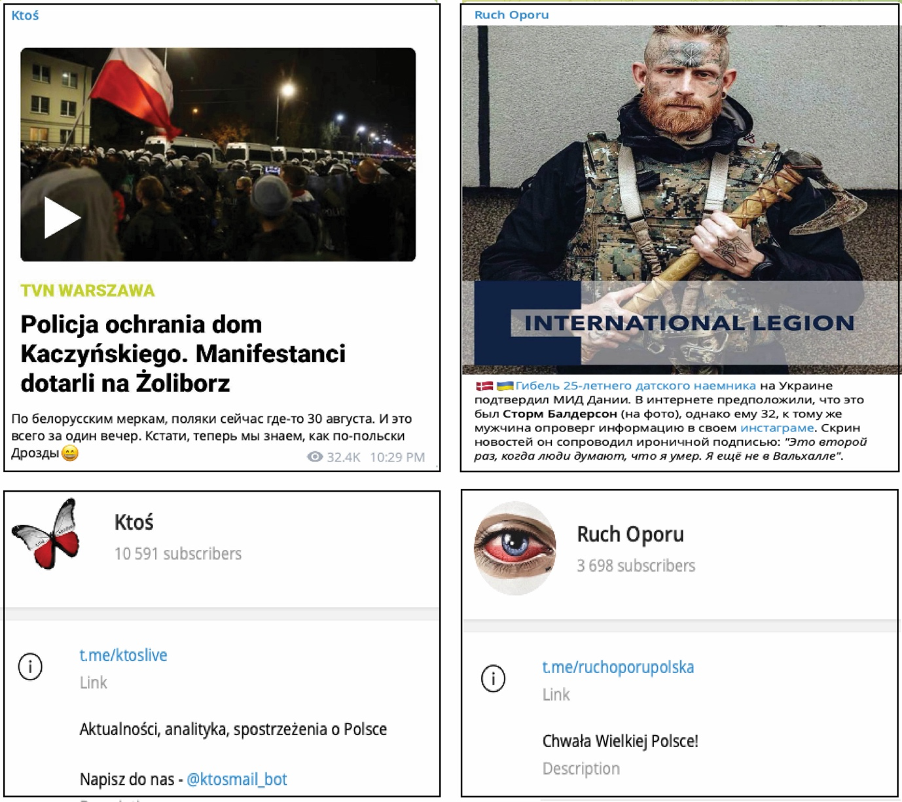
Additionally, some of the Telegram channels have links in their biographies to webpages that publish anti-Ukrainian and pro-Russian content in Polish. Two of these websites, Niezależny Dziennik Polityczny (“Independent Political Journal”) and Wolne Media (“Free Media”), were blocked by Polish authorities in April 2022 for spreading false information about the Ukraine war.
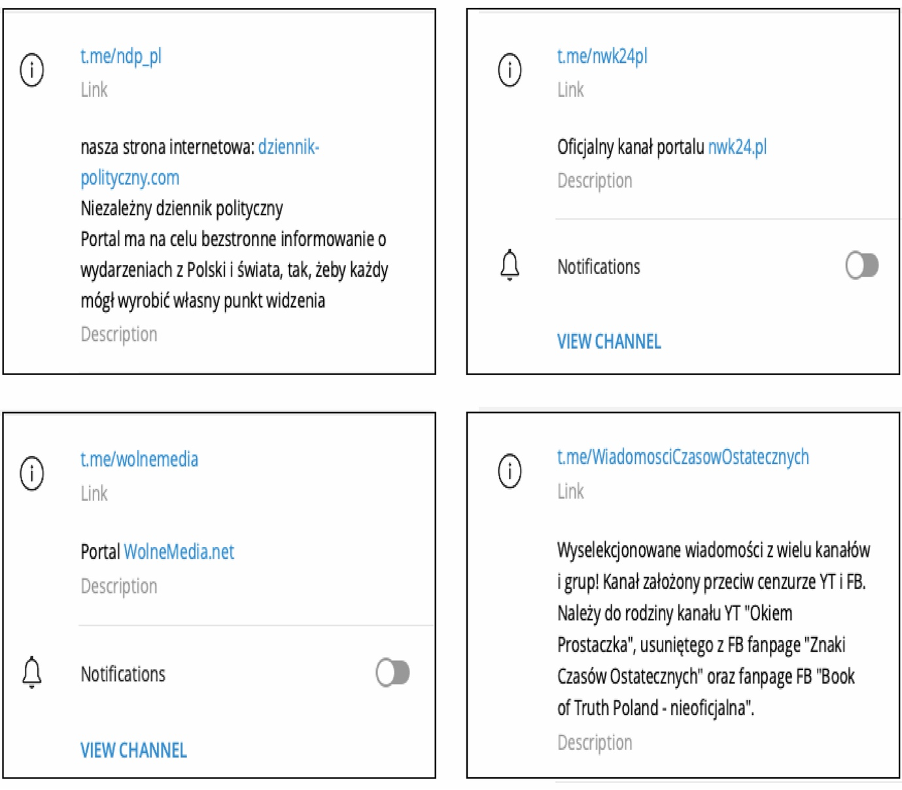
The administrators behind some of the Telegram channels also operate on other social media platforms. One Telegram channel said that it was associated with a “family” of other accounts, which include the YouTube channel Okiem Prostaczka (“Through the eye of a simpleton”), the already removed Facebook page Znaki Czasów Ostatecznych (“Signs of the End Times”), and the Facebook page Book of Truth Poland — nieoficjalna (“Book of Truth Poland — unofficial”), connected to the website Księga Prawdy (“The Book of Truth”). These accounts primarily post religious content. One Telegram channel belongs to the pro-Kremlin Polish journalist Dawid Hudziec, who also runs a Facebook page. He reportedly lives in the breakaway region of Donetsk and works with authorities there.
Most of the Telegram channels typically publish original messages, rather than directly sharing posts from other channels. As the DFRLab documented above, some of the analyzed channels have published identical posts on their accounts. The DFRLab also observed some channels forwarding posts from other channels; the channel NiezaleznyM was the most forwarded, followed by @jupitupi and @ndp_pl.

Analysis of the NiezależnyM Telegram channel determined that the owner of the channel is Miroslaw “Miro” Klimczak; one of his posts says that he lives in New Jersey. The DFRLab found a suspended Twitter account with the same handle. When searching on Twitter for the name Miro Klimczak, one tweet claimed that the account was blocked. As for the second most forward Telegram channel, @jupitupi, it appears to be managed by Wolne Media (“Free Media”), according to one of its posts. The bio of the third most forwarded channel, @ndp_pl, states that it belongs to Niezależny Dziennik Polityczny (“Independent political journal”). As mentioned above, both websites were blocked by Polish authorities in April 2022.
The DFRLab used a measurement algorithm called eigenvector centrality to identify which of the accounts in the network was most influential. The algorithm assigns a relative score to each node in the network, based on the assumption that a node is more important when it is connected to other important nodes. Within this network, the Telegram channels Infokju and Swadomi ranked highest in eigenvector centrality. This analysis also showed that some of the network is connected to a QAnon-related channel called QPolska.
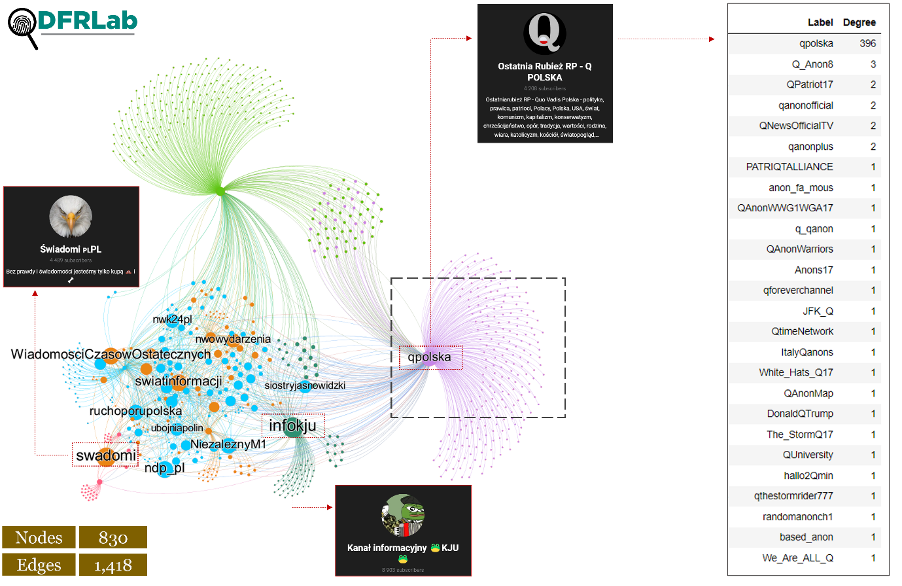
The analyzed Telegram channels also send subscribers to off-platform sites by linking to platforms such as YouTube, Twitter, Rumble, Facebook, and Bitchute. Other linked sites included Polish fringe media outlets, such as nczas.com, dorzeczy.pl, globalna.info, and others. Najwyższy Czas publishes right-wing content and is led by Tomasz Sommer, who reportedly cooperates with Polish right-wing political party Confederation. The DFRLab previously reported on how Confederation leaders mobilized violent groups against non-Ukrainian refugees in March 2022. Dorzeczy.pl is also a Polish right-wing platform which repeatedly spreads disinformation about vaccines. Globalna.info spreads disinformation about the COVID-19 pandemic and 5G antennas. Legaartis.pl is a website run by the Lega Artis law firm; according to Polish fact-checking organization Demagog, it repeatedly spreads false content about Ukrainian refugees.
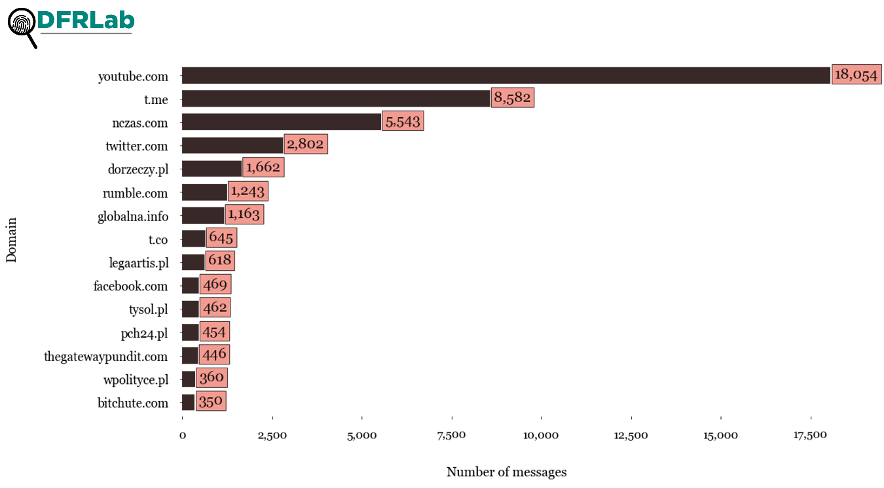
In analyzing the 27 Telegram channels that amplify anti-refugee narratives in Polish, the DFRLab found instances where multiple channels shared identical posts; however, we cannot confirm to what degree, if any, coordination took place between the channels. Around 20 percent of the analyzed channels were created after Russia’s invasion of Ukraine, and some of the Telegram channels are connected to pro-Kremlin Polish websites that have been blocked by authorities for spreading disinformation. Other channels switched from posting in Russian to posting in Polish, suggesting possible links to other countries.
Cite this case study:
Givi Gigitashvili and Esteban Ponce de León, “Polish-language Telegram channels spread anti-refugee narratives,” Digital Forensic Research Lab (DFRLab), May 31, 2022, https://medium.com/dfrlab/polish-language-telegram-channels-spread-anti-refugee-narratives-aaf3ffdc81ed

